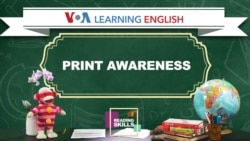Words are all around us and not just in books. Students need to know that words have meaning. Educators call this print awareness. At this early stage, surround learners with English words and sounds.
Experts say that students who cannot read in their own language may not understand some literacy ideas. They need to be taught about the functions of print.
Teaching tips for print awareness
Bring in common items with written language – both the home language and English.
- Bring in calendars, food packages, magazines, mail, maps, and newspapers. Talk about these items. Compare English words with words from the home language.
- Create fun activities with the items. For example, as an art project students can make a birthday card for a friend or family member. They could also make their own food product and make packaging for it.
Post words in your classroom.
- Label common objects in the classroom.
- Post words to songs and poems.
- Post the names and birthdays of students in the classroom.
- Hang colorful posters with English words on the walls.
Read often to your class.
Read books that:
- fit the age and English level of your students.
- repeat simple and useful sentences and words.
- have limited text on a page with pictures explaining the text.
- have active stories.
Make reading aloud fun and active!
- Ask questions about the story. Talk about important words or ideas. But do not stop too often. Students may lose interest in the story.
- Use fun voices, facial expressions, music, objects, and pictures to make the story come to life.
- Make connections to real life. Ask them, “Has this happened to you?”
- Have students retell the story or change the story somehow.
Teach the parts of a book and different types of books.
As you read to your students, teach the parts of a book. Talk about different types of books.
- Explain the purpose of a book’s title and where it is found.
- Point out the names of the author and illustrator. Explain their jobs.
- Show students the page numbers. Explain why pages are numbered.
- Use many different books such as comics and picture books.
Talk about different part of the story.
- Who is the story about (who are the characters)?
- Where does the story take place (the setting)?
- Talk about the problem and the solution. How do characters fix the problem?
Teach punctuation when you read with your students.
- Point out periods, exclamation points, and question marks. Explain what they do.
- Show how punctuation changes the meaning of a sentence.
- Read a sentence with a period and then with an exclamation point with excitement!
Assessment for print awareness
Early learners may not have print awareness. To assess or test for print awareness, give a student a book and ask questions. Here are some examples:
- Where is the title of the book?
- Can you show me the author’s name?
- Where does the story begin?
- Can you show me a letter? A word? A sentence?
- Can you find the first and last words of a sentence?
- Can you show me a punctuation mark? What does a question mark do?
- Can you show me a capital letter? Can you show me a lowercase letter?
Use the tips, strategies, and assessment methods that best serve you and your learners. Change methods to fit your students’ abilities and the teaching situation.
I’m Caty Weaver.
And I’m Anna Matteo.
Anna Matteo wrote this lesson for VOA Learning English. It is part of a larger collection of Early Literacy Materials.
______________________________________________
Words in This Story
function –n. the special purpose that something has or work that it does
label –v. to put an object’s name and information on it to show what it is
poster –n. a large sign or picture meant to gain attention
character –n. a person who appears in a story, play or movie
setting –n. where a story takes place
punctuation –n. markings that make it clear how to separate sentences and parts of sentences, so reading is easier
_____________________________________________
Resources
University of Toronto’s Balanced Literary Diet;
“For Students Who Are Not Yet Fluent, Silent Reading Is Not the Best Use of Classroom Time";
“What Does Research Tell Us About Teaching Reading to English Language Learners?”;






Forum